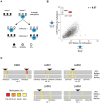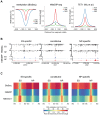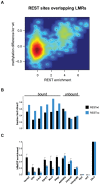Transcription factor occupancy can mediate active turnover of DNA methylation at regulatory regions
- PMID: 24367273
- PMCID: PMC3868540
- DOI: 10.1371/journal.pgen.1003994
Transcription factor occupancy can mediate active turnover of DNA methylation at regulatory regions
Abstract
Distal regulatory elements, including enhancers, play a critical role in regulating gene activity. Transcription factor binding to these elements correlates with Low Methylated Regions (LMRs) in a process that is poorly understood. Here we ask whether and how actual occupancy of DNA-binding factors is linked to DNA methylation at the level of individual molecules. Using CTCF as an example, we observe that frequency of binding correlates with the likelihood of a demethylated state and sites of low occupancy display heterogeneous DNA methylation within the CTCF motif. In line with a dynamic model of binding and DNA methylation turnover, we find that 5-hydroxymethylcytosine (5hmC), formed as an intermediate state of active demethylation, is enriched at LMRs in stem and somatic cells. Moreover, a significant fraction of changes in 5hmC during differentiation occurs at these regions, suggesting that transcription factor activity could be a key driver for active demethylation. Since deletion of CTCF is lethal for embryonic stem cells, we used genetic deletion of REST as another DNA-binding factor implicated in LMR formation to test this hypothesis. The absence of REST leads to a decrease of hydroxymethylation and a concomitant increase of DNA methylation at its binding sites. These data support a model where DNA-binding factors can mediate turnover of DNA methylation as an integral part of maintenance and reprogramming of regulatory regions.
Conflict of interest statement
The authors have declared that no competing interests exist.
Figures





Similar articles
-
Dynamic regulation of 5-hydroxymethylcytosine in mouse ES cells and during differentiation.Nature. 2011 May 19;473(7347):398-402. doi: 10.1038/nature10008. Epub 2011 Apr 3. Nature. 2011. PMID: 21460836
-
5'-Hydroxymethylcytosine Precedes Loss of CpG Methylation in Enhancers and Genes Undergoing Activation in Cardiomyocyte Maturation.PLoS One. 2016 Nov 16;11(11):e0166575. doi: 10.1371/journal.pone.0166575. eCollection 2016. PLoS One. 2016. PMID: 27851806 Free PMC article.
-
Nucleosome repositioning links DNA (de)methylation and differential CTCF binding during stem cell development.Genome Res. 2014 Aug;24(8):1285-95. doi: 10.1101/gr.164418.113. Epub 2014 May 8. Genome Res. 2014. PMID: 24812327 Free PMC article.
-
Cross-talk between site-specific transcription factors and DNA methylation states.J Biol Chem. 2013 Nov 29;288(48):34287-94. doi: 10.1074/jbc.R113.512517. Epub 2013 Oct 22. J Biol Chem. 2013. PMID: 24151070 Free PMC article. Review.
-
DNA methylation: TET proteins-guardians of CpG islands?EMBO Rep. 2011 Dec 23;13(1):28-35. doi: 10.1038/embor.2011.233. EMBO Rep. 2011. PMID: 22157888 Free PMC article. Review.
Cited by
-
CTCF shapes chromatin structure and gene expression in health and disease.EMBO Rep. 2022 Sep 5;23(9):e55146. doi: 10.15252/embr.202255146. Epub 2022 Aug 22. EMBO Rep. 2022. PMID: 35993175 Free PMC article. Review.
-
Dynamic EBF1 occupancy directs sequential epigenetic and transcriptional events in B-cell programming.Genes Dev. 2018 Jan 15;32(2):96-111. doi: 10.1101/gad.309583.117. Epub 2018 Feb 9. Genes Dev. 2018. PMID: 29440261 Free PMC article.
-
Dynamic Enhancer DNA Methylation as Basis for Transcriptional and Cellular Heterogeneity of ESCs.Mol Cell. 2019 Sep 5;75(5):905-920.e6. doi: 10.1016/j.molcel.2019.06.045. Epub 2019 Aug 15. Mol Cell. 2019. PMID: 31422875 Free PMC article.
-
Allele-specific epigenome maps reveal sequence-dependent stochastic switching at regulatory loci.Science. 2018 Sep 28;361(6409):eaar3146. doi: 10.1126/science.aar3146. Epub 2018 Aug 23. Science. 2018. PMID: 30139913 Free PMC article.
-
Guide Positioning Sequencing identifies aberrant DNA methylation patterns that alter cell identity and tumor-immune surveillance networks.Genome Res. 2019 Feb;29(2):270-280. doi: 10.1101/gr.240606.118. Epub 2019 Jan 22. Genome Res. 2019. PMID: 30670627 Free PMC article.
References
-
- Okita K, Ichisaka T, Yamanaka S (2007) Generation of germline-competent induced pluripotent stem cells. Nature 448: 313–317. - PubMed
Publication types
MeSH terms
Substances
LinkOut - more resources
Full Text Sources
Other Literature Sources
Molecular Biology Databases

